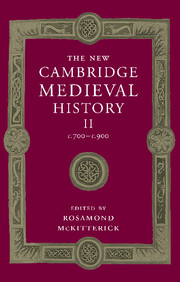Book contents
- Frontmatter
- PART I POLITICAL DEVELOPMENT
- 1 Introduction: sources and interpretation
- 2 The British Isles
- 3 Frankish Gaul to 814
- 4 The Frankish kingdoms, 814–898: the West
- 5 The Frankish Kingdoms, 817–911: the East and Middle Kingdoms
- 6 Fines Imperii: the Marches
- 7 The Vikings in Francia and Anglo-Saxon England to 911
- 8 Scandinavia, c. 700–1066
- 9 Slavs and Bulgars
- 10 The Muslims in Europe
- 11 Spain: the northern kingdoms and the Basques, 711–910
- 12 Lombard and Carolingian Italy
- 13 Byzantine Italy, c. 680–c. 876
- 14 Byzantium and the west, 700–900
- PART II GOVERNMENT AND INSTITUTIONS
- PART III CHURCH AND SOCIETY
- PART IV CULTURE AND INTELLECTUAL DEVELOPMENTS
- Conclusion
- Appendix genealogical tables
- List of primary sources
- Bibliography of secondary works arranged by chapter
- Index of manuscripts
- General index
- Frontispiece">
- Plate section
- Map 4 Charlemagne’s Europe and Byzantium, 814
- Map 19 The ecclesiastical provinces of western Europe 700-900
- Map 20 Carolingian schools, scriptoria and literary centres
- Genealogical table X: Wessex
- References
10 - The Muslims in Europe
from PART I - POLITICAL DEVELOPMENT
Published online by Cambridge University Press: 28 March 2008
- Frontmatter
- PART I POLITICAL DEVELOPMENT
- 1 Introduction: sources and interpretation
- 2 The British Isles
- 3 Frankish Gaul to 814
- 4 The Frankish kingdoms, 814–898: the West
- 5 The Frankish Kingdoms, 817–911: the East and Middle Kingdoms
- 6 Fines Imperii: the Marches
- 7 The Vikings in Francia and Anglo-Saxon England to 911
- 8 Scandinavia, c. 700–1066
- 9 Slavs and Bulgars
- 10 The Muslims in Europe
- 11 Spain: the northern kingdoms and the Basques, 711–910
- 12 Lombard and Carolingian Italy
- 13 Byzantine Italy, c. 680–c. 876
- 14 Byzantium and the west, 700–900
- PART II GOVERNMENT AND INSTITUTIONS
- PART III CHURCH AND SOCIETY
- PART IV CULTURE AND INTELLECTUAL DEVELOPMENTS
- Conclusion
- Appendix genealogical tables
- List of primary sources
- Bibliography of secondary works arranged by chapter
- Index of manuscripts
- General index
- Frontispiece">
- Plate section
- Map 4 Charlemagne’s Europe and Byzantium, 814
- Map 19 The ecclesiastical provinces of western Europe 700-900
- Map 20 Carolingian schools, scriptoria and literary centres
- Genealogical table X: Wessex
- References
Summary
the muslims in the mediterranean
the confrontation and interaction between Muslin and Christian worlds spread throughout the Mediterranean from east to west. In the east, the conflict was essentially between the Islamic states, notably the Umayyads and ’Abbasids in the eighth century and the ’Abbasids and Tulunids in the ninth, on the one hand, and the Byzantines on the other. This conflict was played out on the long land frontier which ran roughly along the southeastern borders of the Anatolian plateau. It was also played out at sea where, by the beginning of the eighth century, the Muslims had shown themselves adept at naval warfare. The city of Constantinople was able to defend itself, but many of the coastlines and islands of the empire were subject to raids, and some islands, notably Crete, were occupied (Map 4). This struggle lies outside the scope of this volume (for further reading see the bibliography for this chapter). In the western half of the Mediterranean, however, the Muslims were able to establish sustainable states on the European shores and it is with these states that this chapter is concerned.
Sicily, with its ancient Greek and Latin legacies, had long been a half-way house between two cultures. While in Gregory the Great’s time, Latin influence, and especially ecclesiastical connections, remained strong, it seems that the seventh and eighth centuries saw the island becoming increasingly Greek in language, administration and religion. The loss of Syria and Egypt to the Muslims appears to have increased the importance of Sicily to Byzantium.
- Type
- Chapter
- Information
- The New Cambridge Medieval History , pp. 249 - 271Publisher: Cambridge University PressPrint publication year: 1995
References
- 4
- Cited by

